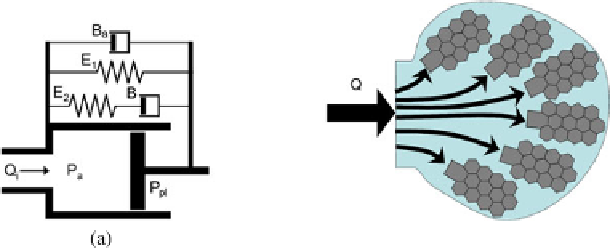Biomedical Engineering Reference
In-Depth Information
Fig. 28.6
(
a
) Maxwell model for a single alveolar duct. (
b
) 3D alveolar duct model of Denny and
Schroter (
2000
) utilized to calibrate the 0D model. (
c
) Construction of an acinus from a tree of
alveolar ducts
both 0D pressure and 3D flowrate are utilized to evaluate the total traction, which
is then applied as a Neumann boundary condition to the 3D boundary. In Fig.
28.7
,
selected simulation results are provided for an overall lung model containing nine
3D airways, 55,000 0D airways, and 28,000 0D acini. The validity of our coupling
approach is illustrated by the perfect matching of pressure curves at associated 3D
and 0D boundaries. The simulated tracheal flowrate is in excellent agreement with
reported physiological flowrates.
28.4 Conclusion and Outlook
In this paper, we have reviewed different types of overall lung models developed
recently in our group. If detailed information about local flow patterns or tissue
stresses and strains are of interest, utilization of 3D models is indispensable. As a
first step, we have established a comprehensive 3D model of individual alveoli con-
sidering not only tissue behavior but also the influence of the covering surfactant
film. Since it is impossible to resolve all 500 million alveoli in the human lung,
we have proposed an advanced multi-scale methodology enabling the simulation of
tissue dynamics at a global level while still resolving alveolar scales locally. To com-
plete the 'bridging of scales', a novel approach for the coupling of 3D parenchyma
and airway models into one overall lung model has been developed. The number of
resolvable 3D airways is, however, limited.
Therefore, we have proposed an alternative reduced-dimensional lung model al-
lowing to effectively study pressure and flow characteristics in the entire conduct-
ing region of the lung. For this purpose, a space-filling artificial airway tree with
attached acini is generated using patient-specific morphological information. Each
airway is modeled as a pipe with nonlinear resistance. The 0D acinus model is based
on a combination of Maxwell models fitted to 3D simulation results from the litera-
ture. The resulting reduced-dimensional lung model was shown to reproduce global
physiological data in a very efficient manner.

















